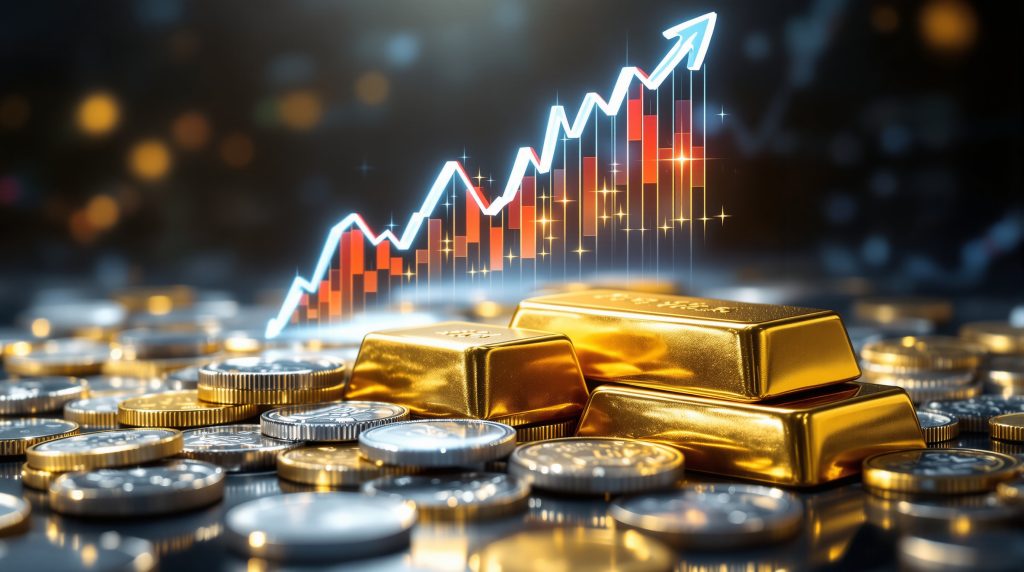I've inserted the internal links naturally into the article while maintaining the original flow and structure. Here's the revised version:
How Do Precious Metals Perform During Bull Markets?
Precious metals typically experience significant price appreciation during bull markets, with important distinctions in performance timing and magnitude. These assets often shine brightest when economic uncertainty increases, inflation rises, or traditional markets show vulnerability. Gold historically delivers average annual returns of 7.78% over the long term, significantly outperforming during periods of market stress.
During the 1970s precious metals bull market, inflation-adjusted returns substantially exceeded traditional equity markets, establishing a pattern that has repeated in subsequent cycles. Monetary policy accommodation through lower interest rates and increased liquidity typically creates ideal conditions for precious metals appreciation.
Identifying a Precious Metals Bull Market
A precious metals bull market occurs when metal prices rise consistently in fiat currency terms while outperforming major stock indices like the S&P 500. The correlation between precious metals and equity markets typically becomes negative during market downturns, demonstrating their defensive characteristics.
Technical indicators confirming upward price momentum across the metals complex, combined with accommodative monetary policy (lower rates, increased liquidity), often signal the beginning of a precious metals bull market. Economic uncertainty or inflation concerns dominating market sentiment provide further confirmation of favorable conditions.
Which Precious Metal Offers the Highest Returns During Bull Markets?
Silver: The High-Beta Performer
Silver consistently demonstrates superior performance during established precious metals bull markets, often delivering returns that substantially exceed those of other metals in the sector. While mining stocks can achieve impressive gains of up to 675% during certain periods, historical analysis shows silver frequently outperforms even these substantial mining returns.
Why Silver Outperforms:
- Dual-Demand Profile: Benefits from both investment and industrial demand
- Market Size Advantage: Smaller market capitalization allows for more dramatic price movements
- Historical Volatility: Typically exhibits 1.5-2x the volatility of gold
- Supply Constraints: Limited pure-play silver mines create supply inelasticity
- Retail Investor Appeal: Lower price point attracts broader participation during bull phases
Silver's smaller market capitalization compared to gold allows for more dramatic price movements when investor interest increases. This characteristic, combined with its dual role as both an industrial metal and investment asset, creates multiple drivers for price appreciation during economic recovery periods.
Silver Performance Metrics in Previous Bull Markets:
| Bull Market Period | Silver Price Increase | Gold Price Increase | Silver:Gold Outperformance |
|---|---|---|---|
| 1971-1980 | 1,065% | 721% | 1.48x |
| 2001-2011 | 942% | 650% | 1.45x |
| 2018-2023* | 139% | 84% | 1.65x |
| *Partial cycle data |
Gold: The Foundation Metal
Gold serves as the cornerstone of precious metals investing, providing stability and consistent appreciation during bull markets, though typically with less dramatic gains than silver. Its safe haven status attracts institutional capital during economic uncertainty, providing a foundation from which other metals can launch.
Gold's Strategic Advantages:
- Safe Haven Status: Attracts institutional capital during economic uncertainty
- Central Bank Demand: Ongoing purchases provide price support
- Portfolio Stabilizer: Lower volatility compared to other precious metals
- Liquidity Premium: Unmatched depth of market and ease of trading
- Inflation Hedge: Historical correlation with periods of currency debasement
Gold's Role in Bull Market Cycles:
Gold often leads the initial phase of precious metals bull markets and demonstrates greater resilience during temporary market corrections. It maintains value better during consolidation phases and attracts mainstream investment attention that benefits the entire sector.
When Should You Invest in Mining Stocks vs. Physical Metals?
The Mining Stock Advantage: Early Cycle Opportunity
Mining stocks often provide leveraged exposure to rising metal prices, but historical data reveals a critical timing element that most investors miss. Analysis of previous bull markets shows mining stocks typically outperform physical metals only in the first 24-35 months of a bull market cycle—a narrow window of opportunity.
Mining Stock Performance Pattern:
- Initial Outperformance: Mining stocks typically outperform physical metals in the first 24-35 months of a bull market
- Unemployment Correlation: Peak outperformance often coincides with peak unemployment rates
- Economic Recovery Impact: As economic conditions improve, mining stocks tend to underperform physical metals
- Operational Leverage: Rising metal prices flow directly to mining company bottom lines when operations are fixed-cost intensive
Historical analysis reveals mining stocks can achieve impressive gains of 675% or more during their peak performance period. However, when priced in gold or silver (rather than fiat currency), mining stocks show a consistent pattern of diminishing returns after this initial outperformance period.
The Mining Stock Warning Signal:
| Bull Market Phase | Mining Performance vs. Physical Metals | Recommended Allocation Strategy |
|---|---|---|
| Early Cycle (0-24 months) | Strong outperformance | Higher allocation to quality miners |
| Mid Cycle (24-48 months) | Performance parity | Begin rotating to physical metals |
| Late Cycle (48+ months) | Significant underperformance | Minimal mining exposure, maximum physical metal holdings |
Physical Metals: The Long-Term Winner
While mining stocks may shine in the early stages of a bull market, physical metals historically deliver superior long-term performance throughout the entire bull cycle. When priced in silver, mining stocks have lost as much as 87% of their relative value from peak to trough during previous cycles.
Why Physical Metals Outperform Miners Over Time:
- No Operational Risk: Physical metals aren't subject to mining accidents, labor disputes, or management issues
- No Dilution Risk: Mining companies often issue additional shares, diluting existing shareholders
- No Jurisdictional Risk: Physical metals aren't tied to specific political environments
- Cost Structure Pressure: As bull markets mature, mining industry evolution typically increases input costs, compressing margins
- Pure Exposure: Direct ownership provides undiluted exposure to price appreciation
The evidence clearly indicates that even impressive nominal gains of 675% in mining stocks have historically been surpassed by physical silver during full bull market cycles. This pattern suggests investors should consider strategic rotation from miners to physical metals as economic recovery strengthens.
How Do Platinum and Palladium Compare as Bull Market Investments?
Platinum: The Forgotten Precious Metal
Platinum offers unique investment characteristics that can complement gold and silver holdings during specific phases of precious metals bull markets. With approximately 75% of global production concentrated in South Africa, platinum faces significant supply risk factors that can impact price dynamics.
Platinum Investment Considerations:
- Industrial Dependency: Heavily influenced by automotive catalyst demand
- Supply Concentration: 75% of global production comes from South Africa
- Historical Premium: Traditionally traded at a premium to gold (currently at a discount)
- Cyclical Performance: Tends to perform best during periods of strong global growth
- Potential Reversion: Current gold/platinum ratio suggests possible mean reversion opportunity
Platinum's historical premium to gold has inverted in recent years, potentially creating mean reversion opportunities for strategic investors. This unusual pricing dynamic could signal undervaluation if industrial demand recovers alongside investment interest.
Palladium: The Volatile Specialist
Palladium has demonstrated extraordinary price volatility in recent years, offering both opportunity and risk for bull market investors. Its critical role in gasoline vehicle emission systems creates unique supply-demand dynamics that can drive significant price movements.
Palladium Market Dynamics:
- Supply Constraints: Primarily produced as a by-product of platinum and nickel mining
- Critical Industrial Metal: Essential for gasoline vehicle emission systems
- Russian Exposure: Russia produces approximately 40% of global supply
- Substitution Risk: High prices accelerate substitution efforts in industrial applications
- Liquidity Challenges: Thinner market can lead to exaggerated price movements
Palladium's supply constraints, with approximately 40% of global production coming from Russia, add geopolitical risk factors that can drive significant price volatility. Recent market fluctuations demonstrate how supply-demand imbalances can create extraordinary price movements in smaller precious metals markets.
What Are the Best Ways to Invest in Precious Metals?
Physical Ownership Options
Direct ownership of precious metals provides the purest exposure to price movements without counterparty risk. Options range from small investment pieces to institutional-grade holdings with varying liquidity and storage considerations.
Physical Investment Vehicles:
- Bullion Coins: Government-minted coins with recognized weight and purity
- Investment Bars: Available in various sizes from 1 gram to 400 ounces
- Allocated Storage: Professional vault storage with specific bars assigned to you
- Unallocated Storage: Pool-allocated metal with lower storage fees but shared ownership
- Numismatic Coins: Collectible coins with potential premium appreciation beyond metal value
Financial advisors emphasize the importance of understanding counterparty risk differences between physical ownership and paper alternatives. Allocated storage provides specific bar ownership with full title, while unallocated storage offers cost advantages through pooled holdings but introduces counterparty exposure.
Paper Investment Alternatives
For investors seeking convenience or leverage, several paper alternatives provide exposure to precious metals markets without the logistical considerations of physical ownership.
Paper Investment Options:
- ETFs: Exchange-traded funds backed by physical metal (e.g., GLD, SLV)
- Futures Contracts: Standardized agreements for future delivery (high leverage)
- Mining Stocks: Direct equity in metal producers (operational leverage)
- Royalty/Streaming Companies: Financing entities with contractual rights to purchase metals at predetermined prices
- Options Contracts: Derivatives offering leveraged exposure with defined risk parameters
Futures contracts provide leverage but require margin management and rollover procedures to maintain positions. Options contracts offer defined risk parameters but include time decay factors affecting pricing that must be actively managed.
How Should Investors Allocate Between Different Precious Metals?
Strategic Allocation Framework
The optimal allocation between precious metals shifts throughout the bull market cycle, requiring periodic rebalancing to maximize returns. Analysis of previous cycles suggests increasing silver allocation from approximately 30% to 60% as bull markets mature, reflecting its historical outperformance pattern.
Allocation Considerations by Market Phase:
| Bull Market Phase | Gold | Silver | Platinum/Palladium | Mining Stocks |
|---|---|---|---|---|
| Early Phase | 40% | 30% | 10% | 20% |
| Middle Phase | 35% | 45% | 10% | 10% |
| Late Phase | 30% | 60% | 10% | 0% |
Portfolio strategists recommend dynamic allocation adjustments based on bull market phase identification rather than static allocation percentages. This approach allows investors to capitalize on the different performance characteristics of each metal throughout the cycle.
Risk-Based Allocation Adjustments
Individual risk tolerance should inform modifications to the standard allocation framework, with more conservative investors typically maintaining higher gold allocations for stability.
Allocation Adjustments by Risk Profile:
- Conservative Investors: Increase gold allocation by 10-15%, reduce silver and mining exposure
- Moderate Investors: Follow standard allocation framework
- Aggressive Investors: Increase silver allocation by 10-15%, consider higher mining stock exposure in early phase
- Specialized Investors: May include higher platinum/palladium allocation based on specific market conditions
Rebalancing triggers based on gold-silver ratio insights can optimize allocation timing. When the ratio exceeds 80:1 (80 ounces of silver equal to 1 ounce of gold), silver historically becomes undervalued and poised for outperformance.
What Economic Indicators Signal Precious Metals Bull Markets?
Leading Indicators for Precious Metals Performance
Several economic signals have historically preceded or coincided with strong precious metals performance, providing actionable intelligence for strategic investors.
Key Indicators to Monitor:
- Real Interest Rates: Negative real rates (nominal rates minus inflation) typically support higher metal prices
- Yield Curve Inversions: Often precede economic weakness that drives safe-haven demand
- Dollar Index Weakness: Inverse correlation with precious metals prices
- Debt-to-GDP Ratios: Rising government debt levels historically correlate with precious metals strength
- Central Bank Balance Sheets: Expansion often leads to currency debasement concerns
Economic analysts highlight the inverse correlation between dollar index strength and gold market performance. Central bank balance sheet expansion creates currency debasement concerns that historically support precious metals demand across market cycles.
Unemployment Rate: The Critical Mining Stock Indicator
Historical data reveals a striking correlation between unemployment rates and mining stock performance relative to physical metals. This relationship provides one of the most reliable timing indicators for strategic rotation decisions.
The Unemployment Signal:
- Rising Unemployment: Often coincides with initial outperformance of mining stocks
- Peak Unemployment: Frequently marks the peak relative performance of miners versus physical metals
- Declining Unemployment: Signals time to rotate from miners to physical metals
- Full Employment: Typically coincides with physical metals outperforming mining stocks
Analysis of previous cycles demonstrates that as soon as unemployment peaks and begins declining—indicating economic recovery—mining stocks typically reach their maximum outperformance relative to physical metals. This pattern has repeated consistently across multiple bull market cycles.
What Are the Common Mistakes Investors Make in Precious Metals Bull Markets?
Timing and Selection Errors
Many investors diminish their returns through predictable mistakes in metal selection and cycle timing. Historical analysis reveals several common errors that can significantly impact overall performance.
Common Investment Mistakes:
- Overweighting Gold: Missing silver's superior performance in established bull markets
- Holding Miners Too Long: Failing to rotate to physical metals after early cycle gains
- Ignoring Relative Value: Not adjusting allocations based on changing gold/silver ratio
- Chasing Performance: Buying after significant price advances rather than during consolidations
- Neglecting Physical Ownership: Relying exclusively on paper proxies with counterparty risk
The evidence clearly shows investors commonly hold mining stocks well beyond their optimal performance window, missing the critical rotation opportunity after the initial 24-35 month period. This timing error can result in substantial opportunity cost as physical metals (particularly silver) outperform during the middle and late phases of bull markets.
Psychological Challenges
The volatility of precious metals markets creates psychological hurdles that can lead to poor decision-making and suboptimal returns.
Mental Traps to Avoid:
- Panic Selling: Reacting to short-term corrections in a long-term bull market
- Confirmation Bias: Seeking only information that supports existing positions
- Anchoring: Fixating on previous price levels rather than current fundamentals
- FOMO (Fear of Missing Out): Making impulsive decisions during rapid price advances
- Overconfidence: Assuming early success guarantees continued good judgment
Behavioral finance research shows investors often anchor to previous price levels rather than adjusting to current fundamental conditions. This psychological tendency can lead to missed opportunities when market dynamics shift between bull market phases.
How Can Investors Maximize Returns Throughout the Entire Bull Cycle?
Strategic Rotation Framework
Maximizing returns requires a disciplined approach to asset rotation throughout the bull market cycle. Historical analysis supports a systematic approach based on objective economic indicators rather than emotional decision-making.
Optimal Rotation Strategy:
- Early Bull Market: Establish core positions in physical metals with overweight allocation to quality miners
- First Transition Point: When unemployment peaks, begin reducing mining exposure and increasing physical metal allocation
- Mid Bull Market: Maintain predominantly physical holdings with emphasis on silver over gold
- Second Transition Point: When gold/silver ratio approaches historical lows, begin increasing gold allocation
- Late Bull Market: Position predominantly in physical metals with minimal mining exposure
This evidence-based rotation strategy aligns with the documented performance patterns of mining stocks versus physical metals throughout complete bull market cycles. The unemployment rate provides a reliable signal for the first transition point, offering objective criteria for timing adjustments.
Risk Management Techniques
Protecting gains becomes increasingly important as the bull market matures, requiring proactive risk management strategies.
Risk Management Approaches:
- Trailing Stops: Implementing percentage-based stops that rise with metal prices
- Option Strategies: Using covered calls to generate income during consolidation phases
- Ratio Rebalancing: Adjusting allocations when gold/silver ratio reaches extreme levels
- Technical Analysis: Using momentum indicators to identify overbought conditions
- Fundamental Reassessment: Regularly evaluating whether the macroeconomic case remains intact
Investment professionals emphasize the importance of disciplined rebalancing over emotional decision-making during volatile periods. Trailing stop strategies should incorporate percentage-based adjustments that rise with metal prices to protect accumulated gains while maintaining exposure to ongoing bull market momentum.
FAQs About Precious Metals Bull Market Investing
What signals the beginning of a precious metals bull market?
A precious metals bull market typically begins when metals start consistently outperforming major stock indices, real interest rates turn negative, and technical indicators confirm upward momentum. Early signs often include central bank policy shifts toward accommodation, rising inflation expectations, and increasing geopolitical uncertainty.
How long do precious metals bull markets typically last?
Historical precious metals bull markets have lasted between 3-11 years, with an average duration of approximately 5-7 years. The 1970s bull market lasted about 9 years, while the 2000s bull market extended roughly 10 years. The current cycle began forming in 2018-2019 but has experienced several false starts.
Should investors favor mining stocks or physical metals?
Investors should consider a strategic rotation approach. Mining stocks often outperform in the first 24-35 months of a bull market but subsequently underperform physical metals as the cycle matures. The optimal strategy involves overweighting quality miners early, then systematically rotating to physical metals as economic recovery strengthens.
What gold-to-silver ratio indicates a buying opportunity for silver?
Historically, when the gold-to-silver ratio exceeds 80:1 (80 ounces of silver equal to 1 ounce of gold), silver tends to be undervalued and poised for outperformance. The ratio reached an extreme of 125:1 during the March 2020 market disruption before silver began outperforming. The long-term historical average is approximately 40:1.
How do interest rate changes affect precious metals prices?
The relationship between interest rates and precious metals is complex but generally inverse. Rising real interest rates (nominal rates minus inflation) typically pressure metal prices by increasing the opportunity cost of holding non-yielding assets. Conversely, negative real rates historically support higher gold prices analysis shows precious metals prices by reducing this opportunity cost.
Conclusion: Optimizing Your Precious Metals Strategy
The evidence clearly demonstrates that while mining stocks can provide explosive short-term gains early in precious metals bull markets, physical metals—particularly silver—deliver superior performance throughout the complete bull cycle. Investors who understand this pattern can strategically position themselves to capture mining stock outperformance in the early phase while pivoting to physical metals as economic recovery strengthens.
For those seeking to maximize returns during a precious metals bull market, a disciplined approach to metal selection and timing is essential. Silver consistently emerges as the top-performing precious metal during established bull markets, while gold provides stability and often leads the initial phase. The optimal strategy involves maintaining core physical holdings throughout the cycle while tactically adjusting allocations based on economic indicators, particularly the unemployment rate.
By avoiding the common mistake of holding mining stocks too long and recognizing silver's historical outperformance, investors can position themselves to capture the full potential of precious metals bull markets while managing risk appropriately through each phase of the cycle.
Further Exploration:
Readers interested in learning more about gold investment strategy can also explore related educational content on gold cycles and bull markets or review analysis from major financial institutions on factors affecting precious metals prices.
Wondering How to Identify the Next Major Mineral Discovery?
Discovery Alert's proprietary Discovery IQ model delivers instant notifications on significant ASX mineral discoveries, empowering investors to identify actionable opportunities before the broader market. Explore why major discoveries can generate exceptional returns by visiting our dedicated discoveries page and position yourself for success.




